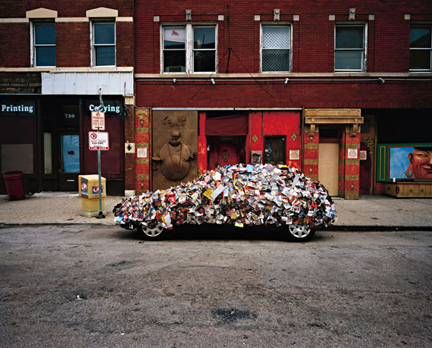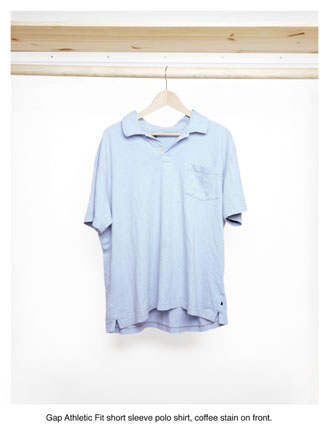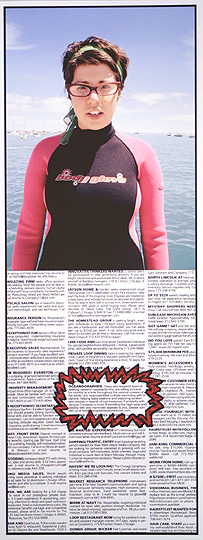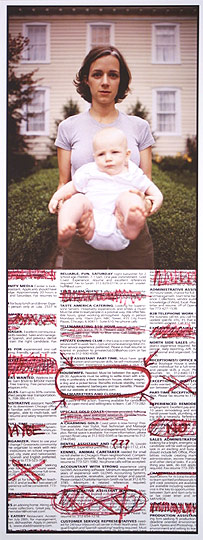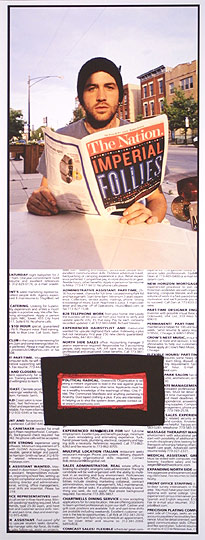Jonathan Gitelson
(b. 1975; resides Chicago, IL)
Jonathan Gitelson converts his observations of ordinary objects or events into exaggerated photographs and graphic posters. Gitelson states: “Commonplace things fascinate me. Overheard conversations, chance encounters and found objects are just a few of the seemingly mundane things that have inspired my work. By examining the overlooked artifacts of everyday life such as discarded letters or receipts, I catch a glimpse into the daily lives of people in my community.”
The Midwest Photographers Project holds works by Gitelson from three separate series: Dream Job, The Car Project and Hidden Clothing, which are each thematically linked by a philosophical exploration of the everyday.
In the series Dream Job, graphic posters playfully combine text and image, pairing a portrait of one of the photographer’s friends with a fabricated classified ad for the sitter’s dream job. One poster features a girl in a wet suit paired with a job description for an oceanographer. Job responsibilities include swimming with dolphins and exploring sunken sea vessels in search of lost treasure. Another ad searches for a political radical who is “willing to lead the war against globalism, capitalism and many other ‘isms’—duct-taped clothing a plus.” By enacting exaggerated roles that recall the cultural stereotypes of a given profession, Gitelson’s dreamers sensationalize the common experience of using a newspaper want ad to imagine one’s self in a new occupation. As a series, the works emphasize the imaginative spirit of ordinary people who envision their life through the fantasies of popular culture.
Gitelson started The Car Project in 2004 after moving across the street from one of Chicago’s West Loop nightclubs, The Funky Buddha Lounge. Each morning he found fliers advertising nightclubs from around the city underneath his windshield wiper and castoff along the street. Inspired by this form of advertising turned instant garbage, Gitelson began collecting the fliers and soon had over one thousand. He then sewed his collection into a handmade car cover that was placed over his parked car in front of the eight nightclubs that most frequently targeted his neighborhood. By photographing his flier-plastered car in front of the clubs—and then exhibiting the photographs alongside the actual car cover covering a metal sculpture made to resemble the shape of the original car—Gitelson humorously illuminates the lengths Chicagoans must go to in order to avoid unwanted solicitation as well as the absurd amount of waste produced in creating this form of ineffective advertising.
Hidden Clothing documents what Gitelson calls “Items of Clothing Secretly Hidden by My Girlfriend (so I wouldn’t wear them anymore).” In the photographs, articles of worn clothing, like a J. Crew sweater and a pair of Wigwam Canada outdoor boot socks, hang alone and lifeless in an empty closet. Looking at these tattered objects, one can form a narrative to the process of the clothing’s destruction and a portrait of sorts of the person that loved these items to a point of ruin. Left unresolved, viewers must wonder whether Gitelson is creating a final document of his clothes just before they are discarded or if he is cataloging them as unearthed treasures, examining his own past as an archeologist would of a lost culture or era.
Jonathan Gitelson holds a BA in literature and photography from Marlboro College, Vermont (1997) and an MFA in photography from Columbia College Chicago (2004). His work has been widely exhibited in the U.S. and abroad at galleries and institutions including the Nelson Hancock Gallery in Brooklyn, NY (2008), DNJ Gallery in Los Angeles, CA (2008, 2009), and at Galerie f5.6 in Munich, Germany (2007). Gitelson’s work is in the permanent collections of the Museum of Contemporary Art, Chicago; Museum of Modern Art, New York; and Victoria and Albert Museum, London, among other institutions.
